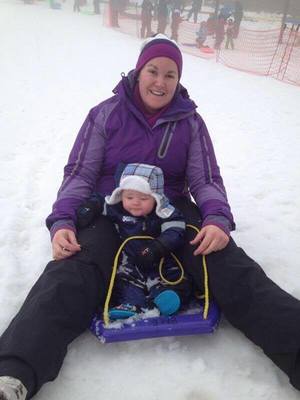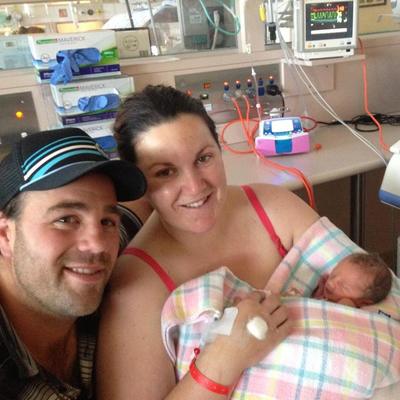By Jade Glen
NAOMI Bawden’s first pregnancy came to a dramatic conclusion, with little Dylan entering the world by emergency caesarean at just 33 weeks and six days.
“I was 31 weeks pregnant when my blood pressure went up and I was started on medication, more frequent doctor trips and CTG scans to monitor my baby’s activities. I was given a hope blood pressure monitor and was doing readings three times a day,” she said.
“In my 33rd week I had tests and scans on the Monday and my doctor rang late Tuesday afternoon asking me to take my blood pressure – it was pretty high. They wanted me to come in ASAP so they could monitor me while they adjusted my medication. My husband Clayton drove me to hospital and got me settled in, and as we run a dairy farm he then went home – we both assumed he would just come and pick me up the next day.”
However, things took a turn around midnight when Naomi started getting heartburn-like pains in her chest.
“They gave me tablets and antacids but it didn’t help. Next thing I know there’s an ambulance transfer there to take me to Sale Hospital, with no real indication as to why. Arriving at Sale I had many more blood/urine tests and was hooked up to drips and monitors.
“If they told me why I can’t remember, I just remember feeling exhausted. They told me I’d be transferred to Monash Clayton so I phoned my husband to tell him don’t come here, just head to Melbourne.
“When the ambulance turned on lights and sirens to get to the helipad at Traralgon I thought things were getting serious but was too exhausted to care much.
“A lovely midwife travelled with me from Sale to Monash, holding my hand the whole way. If not for her calmness I am sure I would have been a mess.”
Arriving at Monash Hospital, Naomi was told that she would be having her baby that very day.
“I panicked and told them I was too tired to push but I didn’t want the big needle in my back either … they told me it was an emergency and I needed a caesarean section under general anaesthetic. That was the last thing I remember.
“I woke about a day later, in ICU to be told by my husband that our little man was OK and in the NICU. I finally got to meet him and we named him Dylan, all 1.8 kilograms of him … so tiny but the strongest little bundle of love.
“I spent one week in the maternity ward trying to get my blood pressure and bloods back under control and Dylan spent four weeks in the NICU, thankfully with no health issues, just gaining weight.
“After my whirlwind week of not knowing much, my doctors told me I had HELLP syndrome. It had threatened not just my baby but put me at risk of stroke, kidney failure and bleeding out among other things.
“I’m so lucky to be here and have a happy healthy now 20 month-old and as scary as it was, I had his little brother with just 14 months between them! (That pregnancy, although unnoticed for three months, went smoothly in comparison).”
What is HELLP syndrome?
HELLP syndrome is the medical name given to a serious complication of Pre Eclampsia involving a combination of liver and blood disorders.
HELLP stands for H (haemolysis – red blood cell damage); EL (elevated liver enzymes – indicating liver damage); and LP (low platelets in the blood leading to a bleeding tendency).
HELLP syndrome may be associated with other signs of Pre Eclampsia, such as high blood pressure, protein in the urine and swelling of the hands, feet or face.
As with the more typical cases of Pre Eclampsia, HELLP syndrome can arise at any stage during the second half of pregnancy.
The diagnosis of HELLP syndrome can be made by blood tests which examine liver enzymes, red blood cells and platelets.
As with typical Pre Eclampsia, delivery is required for cure of the HELLP syndrome, irrespective of the stage of the pregnancy and maturity of the baby.
* Definition from AAPEC – Australian Action on Pre-Eclampsia









